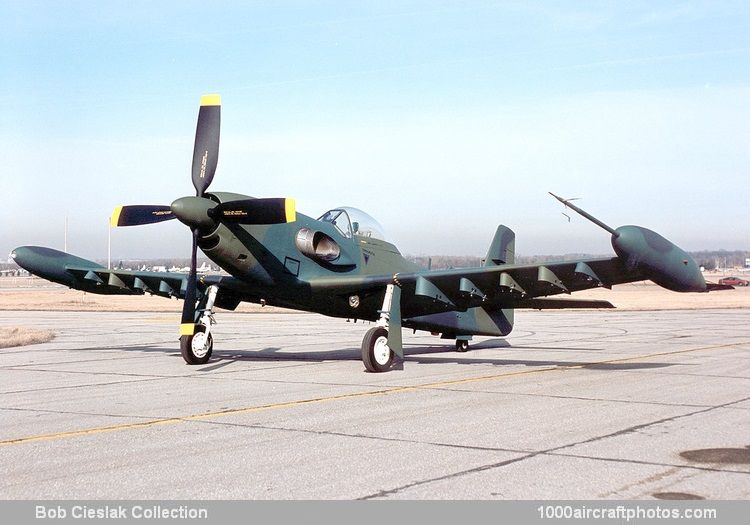03/31/2009. Remarks by Bob Cieslak: "The PA-48 Enforcer was a very cost effective airplane that fulfilled every function of its intended mission, yet its fate was just to be a museum display piece.
I worked for Piper Aircraft Corporation in Lakeland, Florida from 1976 to 1985. During that time I was on the Enforcer Project during the early design stages of the program. Tom Cook was the program manager and I worked with Will Burgess on the power plant and fuel systems.
The Enforcer concept was the brainchild of David Lindsay, owner of the Cavalier Aircraft Company, in the late 1960s. He re-engined an F-51D with an 1,740 eshp Rolls-Royce Dart 510 turboprop and flight tested the aircraft (N6167U) as the Turbo-Mustang III in response to the USAF PAVE COIN program. However, the USAF had no interest in Lindsay's prototype and so rights were sold to Piper Aircraft in 1970.
Combat experience in Vietnam indicated a great need for a low cost, high performance close support aircraft. Piper undertook an ambitious and aggressive effort to pursue a contract under the PAVE COIN program and over the next eight years lobbied Congress to have the USAF formally evaluate the Enforcer. This resulted in the 1979 Defense Bill in which $11.9 million was allocated for Piper to build two new prototypes for flight evaluation by the USAF. By 1980 Piper had built a new engineering building at the Lakeland facility and a portion of the building was sectioned off with a floor-to-ceiling curtain for the Enforcer Project, as called for in the USAF contract. The aircraft received civil registrations, N481PE (c/n 48-8301001) and N482PE (c/n 48-8301002).
Piper used an 1,455 shp Lycoming T55-L-8 turboprop from a helicopter mated to a four-blade cut-down Lockheed Electra propeller. This arrangement created challenges to get proper oil pressure and lubrication because a vertical engine was mounted horizontally.
The Enforcer was essentially a new airplane, using only 10% of original P-51 parts, and in production even those would need a complete redesign. There was only a slight resemblance to the original P-51 airframe. New wings were designed with ten under-wing hard-points for external pods. The structure was strengthened to absorb the increased shock loads. The fuselage was lengthened aft of the wing by 19 in (48.3 mm) and tail surface area was increased. A rocket-actuated ejection seat was installed in the single seat cockpit.
David Lawrence was Piper's chief Enforcer test pilot. He was an ex USAF T-38 pilot with an extensive record of flight test work. April 9, 1983 was the big day for the first flight. All of Piper's engineering, flight test and experimental personnel were gathered around the Enforcer as Dave climbed into the cockpit. He made a low-speed run down the runway and then a high-speed run with the tail off the ground. Then Dave put the throttle to the firewall. The plane accelerated very quickly and was off the ground by mid-field. Dave headed to the flight test area and after about a half-hour he returned, made a fly-over and landed. The only problem he had encountered was a radio problem. The second prototype flew three months later on July 8, 1983.
We flew the Enforcer every day, weather permitting, for several months to get them ready for the USAF evaluation. We installed deactivated armament on the hard-points to develop performance data, including two GE GPU 30mm gun pods (Gattling guns), CBU canisters, Mk.82 Snakeyes and CRV7 rockets. Dave Lawrence told me that the airplane had a maximum speed of 400 mph (644 kmh) and cruised comfortably at 360 mph (579 kmh) at 36,000 feet. With the Gattling guns installed the Enforcer had a combat radius of 450 mls (724 km).
The evaluations were conducted by the USAF at Eglin AFB, Florida, and Edwards AFB, California during 1983 and 1984. The aircraft performed well in their intended role but, as we suspected, the USAF did not buy any. The prototypes were put in dessert storage in late 1986 by the USAF. They were eventually brought out of storage and N481PE is displayed at the National Museum of the USAF at Dayton Ohio, and N482PE is displayed at the Edwards AFB Flight Test Museum. The original PE-1, built in 1971, N201PE c/n PE1-1001, was dismantled and is in storage.
